How to survive some of the most uncomfortable and common travel troubles
Why do you travel? Whether it helps you celebrate the good in your life, makes you forget the dull or merely brings about a welcome change of pace, it is safe to assume that you will not visit far-flung corners of the world for the chance to experience the joys of endemic poisons and dreaded diseases in their natural habitat.
And yet, in some great cosmic joke, the eeriest and most irritating creatures and plants seem to prefer the most appealing, magnificent and coveted locations around the world. Luckily, knowledge is power, and we have all the tips to help you identify and avoid trouble and discomfort wherever you go.
Best practices for remaining happy and healthy
General advice
Always travel with antiseptic lotion as well as an appropriate antihistamine and cream that will soothe bites. Never scratch bites as this will only spread the irritant. In a pinch honey, baking soda, toothpaste or a cube of ice will help soothe the sting.
 Outsmarting mosquitos (and malaria)
Outsmarting mosquitos (and malaria)
 Scorpion and spider situations
Scorpion and spider situations
 Don’t be bugged by bed bugs
Don’t be bugged by bed bugs
 Tick ticks off the list
Tick ticks off the list
 Take the sting out of bees
Take the sting out of bees
 Poison ivy (Toxicodendron radicans)
Poison ivy (Toxicodendron radicans)
 Other poisonous plants to watch out for
Poison oak (Toxicodendron diversilobum – Western U.S; Toxicodendron pubescen – Eastern U.S)
Poison oak is a low-growing shrub (up to 3 ft tall) with compound leaves containing 3 leaflets. The leaflets are lobed with rounded edges, which give it the appearance of an oak tree leaf. It is found mostly on the western US Coast from sea level to 5,000 feet and in the east, predominantly in south-eastern US states in dry, sandy soils.
Poison sumac (Toxicodendron vernix)
The small sumac tree likes water and can be found near swamps in the Southern US. It is common along the Mississippi. It is tall and can affect the face and head.
Poison wood (Metopium toxiferum)
Found in Florida, it can grow 35 feet high with an easily recognizable drooping pinnately compound glossy green leaf with a yellow border. Don’t walk under it when it is or has been raining.
Never burn the leaves from any poisonous plant. If you do inhale the smoke from burning toxic plants, see a doctor immediately.
Also
In Alaska and Hawaii, you can get a severe rash by rubbing against mango skins or eating the fruit from the rind.
Other poisonous plants to watch out for
Poison oak (Toxicodendron diversilobum – Western U.S; Toxicodendron pubescen – Eastern U.S)
Poison oak is a low-growing shrub (up to 3 ft tall) with compound leaves containing 3 leaflets. The leaflets are lobed with rounded edges, which give it the appearance of an oak tree leaf. It is found mostly on the western US Coast from sea level to 5,000 feet and in the east, predominantly in south-eastern US states in dry, sandy soils.
Poison sumac (Toxicodendron vernix)
The small sumac tree likes water and can be found near swamps in the Southern US. It is common along the Mississippi. It is tall and can affect the face and head.
Poison wood (Metopium toxiferum)
Found in Florida, it can grow 35 feet high with an easily recognizable drooping pinnately compound glossy green leaf with a yellow border. Don’t walk under it when it is or has been raining.
Never burn the leaves from any poisonous plant. If you do inhale the smoke from burning toxic plants, see a doctor immediately.
Also
In Alaska and Hawaii, you can get a severe rash by rubbing against mango skins or eating the fruit from the rind.
 Leora Rothschild is the Owner at Rothschild Safaris. Rothschild Safaris specializes in bespoke, luxury travel in Africa and select wildlife-based destinations around the world.
If you would like to be a guest blogger on A Luxury Travel Blog in order to raise your profile, please contact us.
Leora Rothschild is the Owner at Rothschild Safaris. Rothschild Safaris specializes in bespoke, luxury travel in Africa and select wildlife-based destinations around the world.
If you would like to be a guest blogger on A Luxury Travel Blog in order to raise your profile, please contact us.
 Outsmarting mosquitos (and malaria)
Outsmarting mosquitos (and malaria)
- Do visit a travel clinic or your doctor at least 6 – 8 weeks before you travel. Follow all instructions very carefully.
- Apply your anti-mosquito lotion OVER any other creams.
- Pack and wear long sleeves and trousers, especially at dawn and dusk. Tuck trouser legs into socks.
- Sleep under a mosquito net impregnated with permethrin.
- Stick to 50% minimum DEET.
- Mention your trip itinerary to your doctor if you have any flu-like symptoms for a minimum of six months after your return.
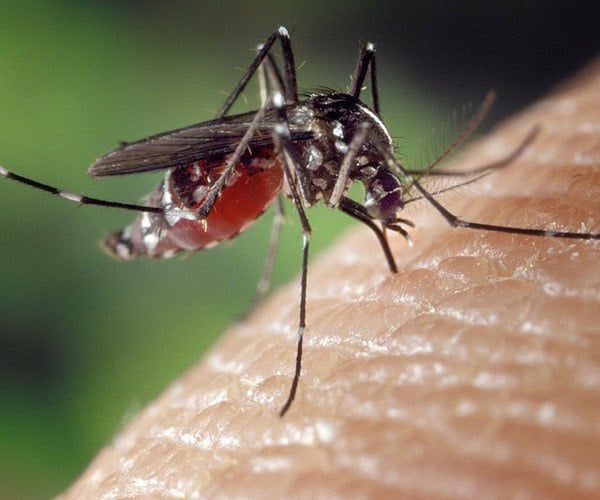 Scorpion and spider situations
Scorpion and spider situations
- Put a rolled up sock in your shoes if you leave them out overnight.
- Ditto for the bottom of your tent zip if you are staying in a tented lodge.
- Don’t put your feet into shoes without checking them for ‘visitors’.
- Contact a doctor if you think you have been bitten.
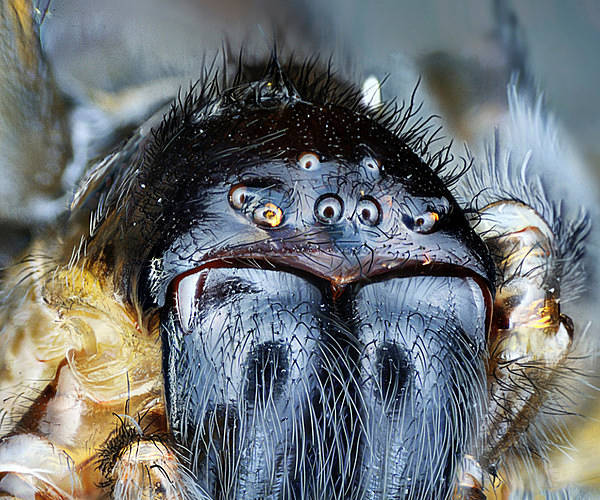 Don’t be bugged by bed bugs
Don’t be bugged by bed bugs
- Always use your luggage racks. Never put your luggage on the bed.
- If you ever suspect bugs ask to be moved (they are visible to the naked eye).
- If you have been bitten treat with antiseptic cream and take an antihistamine if you cannot resist scratching.
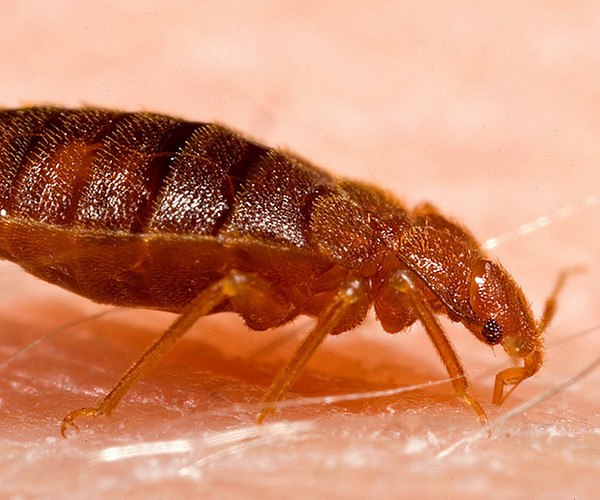 Tick ticks off the list
Tick ticks off the list
- Wear long-sleeved clothes and trousers.
- Garments treated with permethrin and an insect repellent with DEET will all keep the ticks at bay.
- If you spy a tick on your body, always remove with tweezers and never grab it by the body. Aim to grab it by the mouth and pull slowly until it lets go.
- Wash the bite and your hands with warm water and soap.
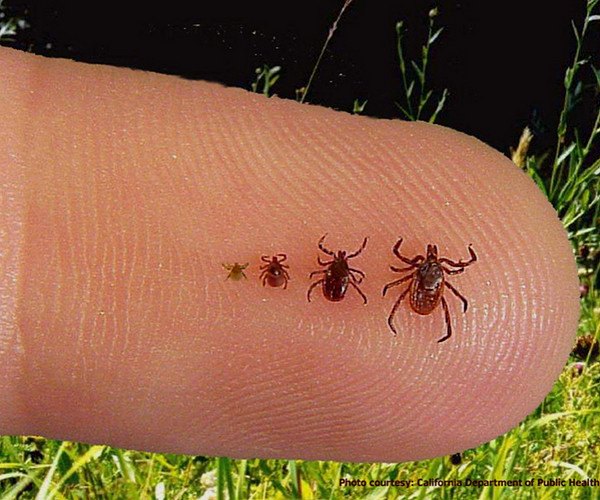 Take the sting out of bees
Take the sting out of bees
- Wear tight clothing. Bees may crawl under loose clothing.
- Don’t wear perfume or cologne.
- If you do find a bee nearby, try to stay still until it has moved along.
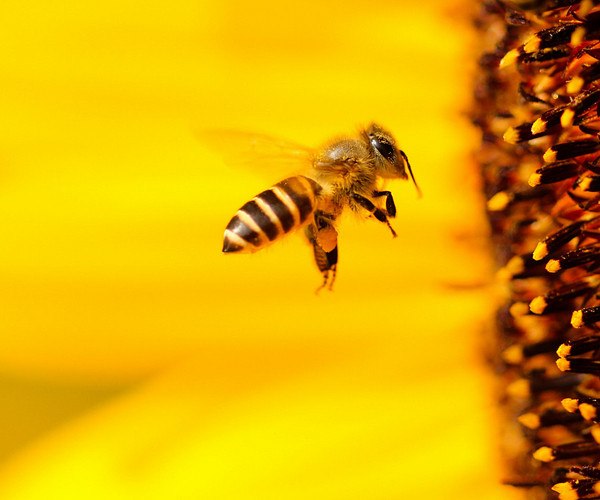 Poison ivy (Toxicodendron radicans)
Poison ivy (Toxicodendron radicans)
- It isn’t really an ivy, and it doesn’t always climb.
- It has a woody stem without thorns and clusters of three leaves with two opposing.
- Poison ivy can be found anywhere in North America, Asia, Bermuda and the Bahamas.
- 80% of the population is allergic to the clear urushiol oil carried by the poison ivy.
- You can get the rash from any part of the plant during any time of the year. A red rash, inflammation, blisters, and scabs may start appearing within 4 to 24 hours after contact.
- You can become allergic to poison ivy over time. Urushiol binds to the skin in 20 minutes, but if it is your first contact, it might take as long as 10 days before you show a rash.
- Animals may not react to the poison ivy, but if your dog rubs against it and you rub your dog, you will get the rash until you wash your dog.
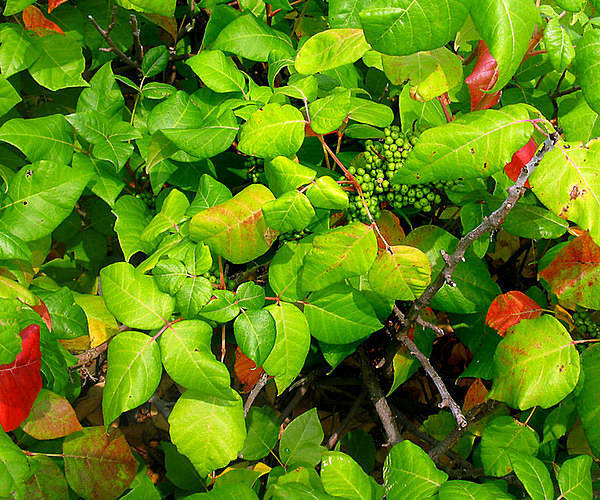 Other poisonous plants to watch out for
Poison oak (Toxicodendron diversilobum – Western U.S; Toxicodendron pubescen – Eastern U.S)
Poison oak is a low-growing shrub (up to 3 ft tall) with compound leaves containing 3 leaflets. The leaflets are lobed with rounded edges, which give it the appearance of an oak tree leaf. It is found mostly on the western US Coast from sea level to 5,000 feet and in the east, predominantly in south-eastern US states in dry, sandy soils.
Poison sumac (Toxicodendron vernix)
The small sumac tree likes water and can be found near swamps in the Southern US. It is common along the Mississippi. It is tall and can affect the face and head.
Poison wood (Metopium toxiferum)
Found in Florida, it can grow 35 feet high with an easily recognizable drooping pinnately compound glossy green leaf with a yellow border. Don’t walk under it when it is or has been raining.
Never burn the leaves from any poisonous plant. If you do inhale the smoke from burning toxic plants, see a doctor immediately.
Also
In Alaska and Hawaii, you can get a severe rash by rubbing against mango skins or eating the fruit from the rind.
Other poisonous plants to watch out for
Poison oak (Toxicodendron diversilobum – Western U.S; Toxicodendron pubescen – Eastern U.S)
Poison oak is a low-growing shrub (up to 3 ft tall) with compound leaves containing 3 leaflets. The leaflets are lobed with rounded edges, which give it the appearance of an oak tree leaf. It is found mostly on the western US Coast from sea level to 5,000 feet and in the east, predominantly in south-eastern US states in dry, sandy soils.
Poison sumac (Toxicodendron vernix)
The small sumac tree likes water and can be found near swamps in the Southern US. It is common along the Mississippi. It is tall and can affect the face and head.
Poison wood (Metopium toxiferum)
Found in Florida, it can grow 35 feet high with an easily recognizable drooping pinnately compound glossy green leaf with a yellow border. Don’t walk under it when it is or has been raining.
Never burn the leaves from any poisonous plant. If you do inhale the smoke from burning toxic plants, see a doctor immediately.
Also
In Alaska and Hawaii, you can get a severe rash by rubbing against mango skins or eating the fruit from the rind.
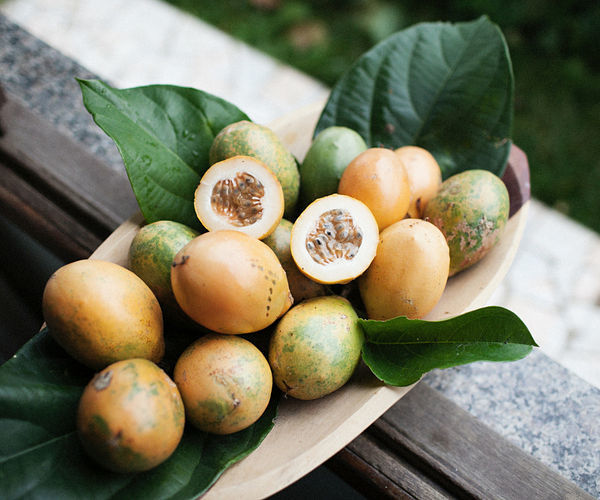 Leora Rothschild is the Owner at Rothschild Safaris. Rothschild Safaris specializes in bespoke, luxury travel in Africa and select wildlife-based destinations around the world.
If you would like to be a guest blogger on A Luxury Travel Blog in order to raise your profile, please contact us.
Leora Rothschild is the Owner at Rothschild Safaris. Rothschild Safaris specializes in bespoke, luxury travel in Africa and select wildlife-based destinations around the world.
If you would like to be a guest blogger on A Luxury Travel Blog in order to raise your profile, please contact us.Did you enjoy this article?
Receive similar content direct to your inbox.


Bugs the biggest anoying small things when traveling in certain areas of the world. Thanks for the tips and another great post. Keep it up!
As they say – those who don’t believe small things can be powerful have not spent a night in a tent with a mosquito!
I think packing a decent antihistamine is key in both cream and tablet if possible. Mosquito bites can be very irritating although I find they don’t seem to like citrusy smells like orange. I really like the bands you can wear as well and found them to be so useful in my trip to Sri Lanka. I had never thought about checking shoes before putting them on so that’s a great tip. I’d also never really thought about poison ivy I feel much more informed now.
Absolutely agree – not everyone has a major reaction to bites but if you do it can definitely spoil your day. Citronella can work against Mosquitos too? Thanks for commenting Dave T.
Plenty of sensible practical advice here and I advise readers to follow it but … sometimes the greatest threats can be at home. Maybe it isn’t Poison Ivy but I planted something in my garden that develops a rash on my hand every time I brush against it. I think I’d be far safer on holiday abroad.
Oh no! So sorry… but yes : you will DEFINITELY be safer on Safari! ;)